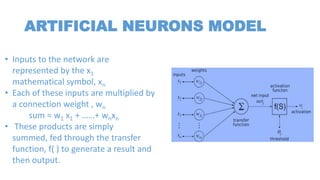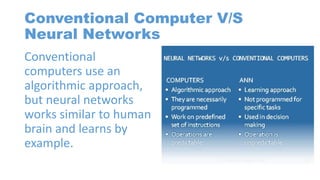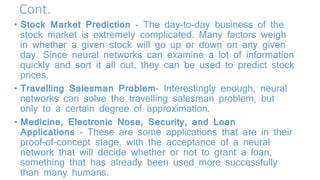Neural network
- 1. NEURAL NETWORK And Artificial Intelligence Presented by: Saddam Hussain, Owais Latif and Qazi
- 2. WHAT IS NEURAL NETWORK? • The method calculation is based on the interaction of plurality of processing elements inspired by biological nervous system called neurons. • It is a powerful technique to solve real world problem. • A neural network is composed of a number of nodes, or units[1], connected by links. Each link has a numeric weight[2]associated with it. . 1. Weights are the primary means of long-term storage in neural networks, and learning usually takes place by updating the weights. 2. Artificial neurons are the constitutive units in an artificial neural network
- 3. WHY USE NEURAL NETWORKS? • It has ability to Learn from experience. • It can deal with incomplete information. • It can produce result on the basis of input, has not been taught to deal with. • It is used to extract useful pattern from given data i.e. pattern Recognition etc.
- 4. Biological Neurons Four parts of a typical nerve cell : • DENDRITES: Accepts the inputs • SOMA : Process the inputs • AXON : Turns the processed inputs into outputs. • SYNAPSES : The electrochemical contact between the neurons.
- 5. ARTIFICIAL NEURONS MODEL • Inputs to the network are represented by the x1 mathematical symbol, xn • Each of these inputs are multiplied by a connection weight , wn sum = w1 x1 + ……+ wnxn • These products are simply summed, fed through the transfer function, f( ) to generate a result and then output.
- 6. NEURON MODEL Neuron Consist of: Inputs (Synapses): input signal. Weights (Dendrites): determines the importance of incoming value. Output (Axon): output to other neuron or of NN .
- 7. Terminology Biological Terminology Artificial Neural Network Terminology Neuron Node/Unit/Cell/Neurode Synapse Connection/Edge/Link Synaptic Efficiency Connection Strength/Weight Firing frequency Node output
- 8. The Learning Process • Associative mapping in which the network learns to produce a particular pattern on the set of input units whenever another particular pattern is applied on the set of input units. Auto-Association. Hetero-Association.
- 9. Associate Mapping Auto-Association. An input pattern associated with itself , and the states of input and output units coincides, this used to provide pattern completion. Hetero-association. Nearest-neighbour recall, where the output pattern produced corresponds to the input pattern stored, which is closest to the pattern presented, and Interpolative recall, where the output pattern is a similarity dependent interpolation of the patterns stored corresponding to the pattern presented. Yet another paradigm, which is a variant associative mapping is classification, i.e. when there is a fixed set of categories into which the input patterns are to be classified.
- 10. • This is learning by doing. • In this approach no sample outputs are provided to the network against which it can measure its predictive performance for a given vector of inputs. • One common form of unsupervised learning is clustering where we try to categorize data in different clusters by their similarity. UNSUPERVISED LEARNING • A teacher is available to indicate whether a system is performing correctly, or to indicate the amount of error in system performance. Here a teacher is a set of training data. • The training data consist of pairs of input and desired output values that are traditionally represented in data vectors. • Supervised learning can also be referred as classification, where we have a wide range of classifiers, (Multilayer perceptron , k nearest neighbor..etc) SUPERVISED LEARNING
- 11. THE BACKPROPAGATION ALGORITHM • The backpropagation algorithm (Rumelhart and McClelland, 1986) is used in layered feed-forward Artificial Neural Networks. • Back propagation is a multi-layer feed forward, supervised learning network based on gradient descent learning rule. • we provide the algorithm with examples of the inputs and outputs we want the network to compute, and then the error (difference between actual and expected results) is calculated. • The idea of the backpropagation algorithm is to reduce this error, until the Artificial Neural Network learns the training data.
- 12. Conventional Computer V/S Neural Networks Conventional computers use an algorithmic approach, but neural networks works similar to human brain and learns by example.
- 13. ADVANTAGES OF ANN: • It involves human like thinking. • They can handle noisy or missing data. • They can work with numbers of variables or parameters. • They provide general solution with predictive solution. • System has got property of continuous learning.
- 14. IMPORTANT APPLICATIONS OF NEURAL NETWORKS • Finger Print Recognition System. • Pre-processing System. • Feature Extraction Using Neural Networks • Classifications • Results
- 15. Some Other Applications • Character Recognition - The idea of character recognition has become very important as handheld devices like the Palm Pilot are becoming increasingly popular. Neural networks can be used to recognize handwritten characters. • Image Compression - Neural networks can receive and process vast amounts of information at once, making them useful in image compression. With the Internet explosion and more sites using more images on their sites, using neural networks for image compression is worth a look.
- 16. Cont. • Stock Market Prediction - The day-to-day business of the stock market is extremely complicated. Many factors weigh in whether a given stock will go up or down on any given day. Since neural networks can examine a lot of information quickly and sort it all out, they can be used to predict stock prices. • Travelling Salesman Problem- Interestingly enough, neural networks can solve the travelling salesman problem, but only to a certain degree of approximation. • Medicine, Electronic Nose, Security, and Loan Applications - These are some applications that are in their proof-of-concept stage, with the acceptance of a neural network that will decide whether or not to grant a loan, something that has already been used more successfully than many humans.
- 17. THANK YOU


![WHAT IS NEURAL NETWORK?
• The method calculation is based on the
interaction of plurality of processing
elements inspired by biological nervous
system called neurons.
• It is a powerful technique to solve real
world problem.
• A neural network is composed of a
number of nodes, or units[1], connected
by links. Each link
has a numeric weight[2]associated with it.
.
1. Weights are the primary means of long-term storage in
neural networks, and learning usually takes place by
updating the weights.
2. Artificial neurons are the constitutive units in an artificial
neural network](https://image.slidesharecdn.com/neuralnetwork-170424185049/85/Neural-network-2-320.jpg)














